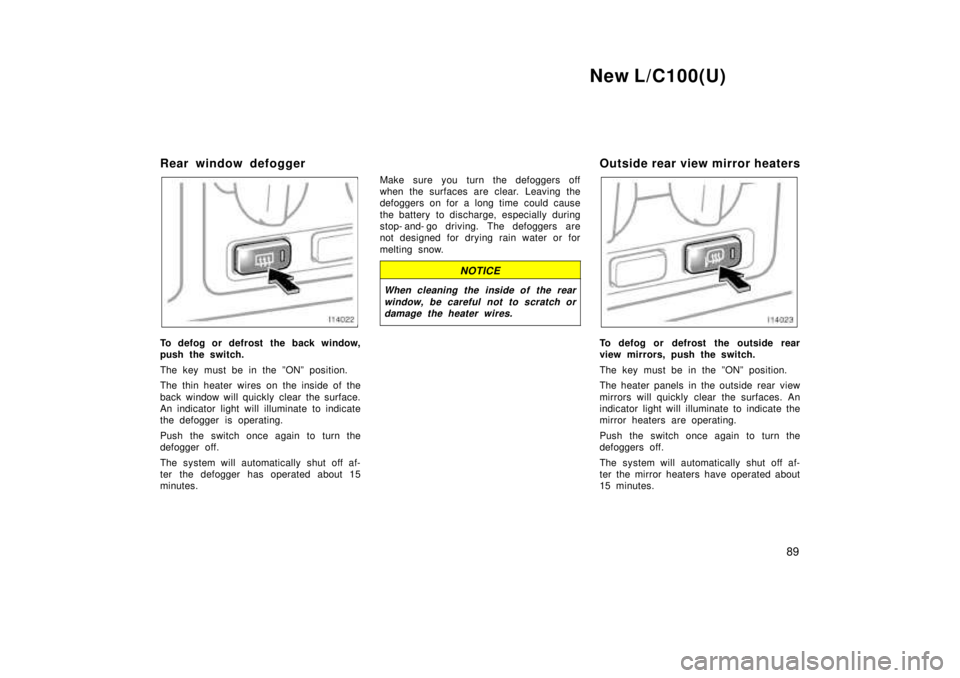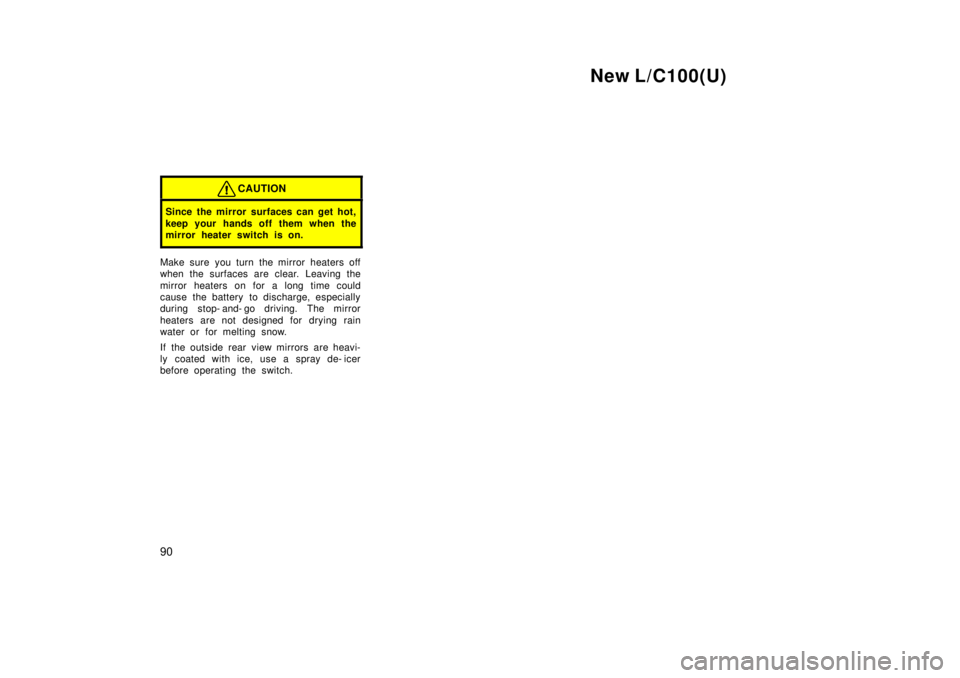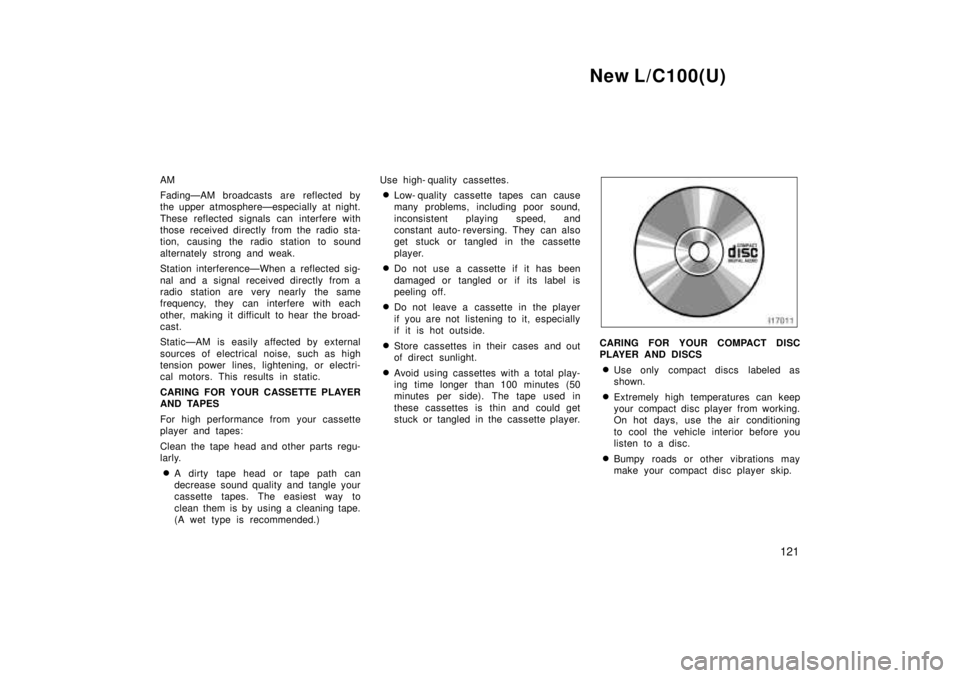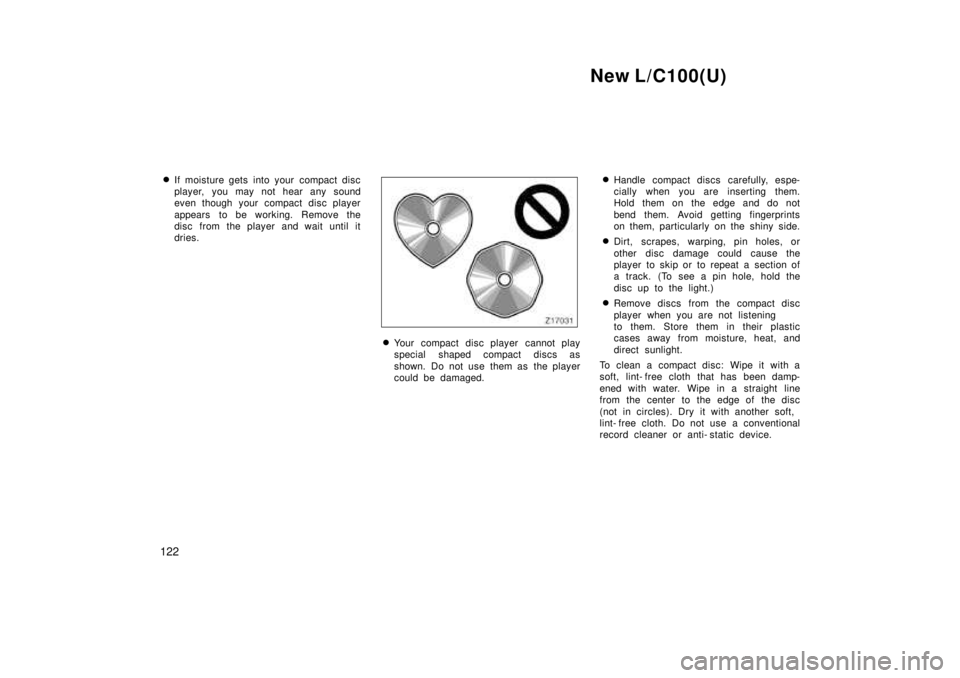1999 TOYOTA LAND CRUISER ESP
[x] Cancel search: ESPPage 45 of 202

New L/C100(U)53
The SRS (Supplemental Restraint Sys-
tem) airbags are designed to provide
further protection for the driver and
front passenger when added to the pri-
mary protection provided by the seat
belts.
In response to a severe frontal impact,
the SRS airbags work together with the
seat belts to help prevent or reduce injury
by inflating, in order to decrease the likeli-
hood of the driver 's or front passenger 's
head or chest directly hitting the steering
wheel or dashboard. The passenger airbag
is activated even with no passenger in the
front seat.
Be sure to wear your seat belt.
CAUTION
A driver or front passenger too close
to the steering wheel or dashboard
during airbag deployment can be
killed or seriously injured. Toyota
strongly recommends that: �The driver sit as far back as pos-
sible from the steering wheel while
still maintaining control of the ve-
hicle.
� The front passenger sit as far back
as possible from the dashboard.
� All vehicle occupants be properly
restrained using the available seat
belts.
This indicator comes on when the igni-
tion key is turned to the ºACCº or
ºONº position. It goes off after about
6 seconds. This means the SRS airbags
are operating properly.
This warning light system monitors the
airbag sensor assembly, front airbag sen-
sors, inflators, warning light, interconnect-
ing wiring and power sources. (For details,
see ºService remainder indicators and
warning buzzersº in Chapter 1- 5.)
SRS driver and front
passenger airbags
Page 46 of 202

New L/C100(U)
54
The SRS airbag system is designed to
activate in response to a severe frontal
impact within the shaded area between
the arrows in the illustration.
There may be the case that the SRS air-
bags will not activate with such an impact
in which the occupant wearing the seat
belt correctly would not get serious injury.
The SRS airbags will deploy if the severi-
ty of the impact is above the designed
threshold level, comparable to an approxi-
mate 25 km/h (15 mph) collision when
impacting straight into a fixed barrier that
does not move or deform.
If the severity of the impact is below the
above threshold level, the SRS airbags
may not deploy. However, this threshold velocity will be
considerably higher if the vehicle strikes
an object, such as a parked vehicle or
sign pole, which can move or deform on
impact, or if it is involved in an underride
collision (e.g. a collision in which the nose
of the vehicle ºunderridesº, or goes under,
the bed of a truck, etc.).
It is possible with collision severity at the
marginal level of airbag sensor detection
and activation that only one of your ve-
hicle's two airbags will deploy.
For the safety of all occupants, be sure
to always wear seat belts.
Collision from the rear
Collision from the side Vehicle rollover
The SRS airbags are not designed to
inflate if the vehicle is subjected to a
side or rear impact, if it rolls over, or
if it is involved in a low- speed frontal
collision.
Page 81 of 202

New L/C100(U)89
Rear window defogger
To defog or defrost the back window,
push the switch.
The key must be in the ºONº position.
The thin heater wires on the inside of the
back window will quickly clear the surface.
An indicator light will illuminate to indicate
the defogger is operating.
Push the switch once again to turn the
defogger off.
The system will automatically shut off af-
ter the defogger has operated about 15
minutes.
Make sure you turn the defoggers off
when the surfaces are clear. Leaving the
defoggers on for a long time could cause
the battery to discharge, especially during
stop- and- go driving. The defoggers are
not designed for drying rain water or for
melting snow.
NOTICE
When cleaning the inside of the rear
window, be careful not to scratch ordamage the heater wires.
Outside rear view mirror heaters
To defog or defrost the outside rear
view mirrors, push the switch.
The key must be in the ºONº position.
The heater panels in the outside rear view
mirrors will quickly clear the surfaces. An
indicator light will illuminate to indicate the
mirror heaters are operating.
Push the switch once again to turn the
defoggers off.
The system will automatically shut off af-
ter the mirror heaters have operated about
15 minutes.
Page 82 of 202

New L/C100(U)
90
CAUTION
Since the mirror surfaces can get hot,
keep your hands off them when the
mirror heater switch is on.
Make sure you turn the mirror heaters off
when the surfaces are clear. Leaving the
mirror heaters on for a long time could
cause the battery to discharge, especially
during stop- and- go driving. The mirror
heaters are not designed for drying rain
water or for melting snow.
If the outside rear view mirrors are heavi-
ly coated with ice, use a spray de- icer
before operating the switch.
Page 104 of 202

New L/C100(U)
11 2
This section describes some of the basic
features on Toyota audio systems. Some
information may not pertain to your sys-
tem.
Your audio system works when the ignition
key is in the ºACCº or ºONº position.
TURNING THE SYSTEM ON AND OFF
Push ºPWR´VOLº to turn the audio system
on and off.
Push ºAM´FMº, ºTAPEº or ºCDº to turn on
that function without pushing ºPWR´VOLº.
You can turn on each player by inserting
a cassette tape or compact disc.
You can turn off each player by ejecting
the cassette tape or compact disc. If the
audio system was previously off, then the
entire audio system will be turned off
when you eject the cassette tape or com-
pact disc. If the another function was pre-
viously playing, it will come on again.
SWITCHING BETWEEN FUNCTIONS
Push ºAM´FMº, ºTAPEº or ºCDº if the sys-
tem is already on but you want to switch
from one function to another.
TONE AND BALANCE
For details about your system's tone and
balance controls, see the description of
your own system.
Tone
How good an audio program sounds to
you is largely determined by the mix of
the treble, midrange, and bass levels. In
fact, different kinds of music and vocal
programs usually sound better with differ-
ent mixes of treble, midrange, and bass.
Balance
A good balance of the left and right stereo
channels and of the front and rear sound
levels is also important.
Keep in mind that if you are listening to
a stereo recording or broadcast, changing
the right/left balance will increase the vol-
ume of one group of sounds while de-
creasing the volume of another.
YOUR RADIO ANTENNA
Lowering the antenna
To lower a power antenna, push the º
�º
(down) switch. Also, the antenna automati-
cally goes down when the radio mode is
switched off to turn on the cassette tape
player or compact disc player, turning off
the audio system by pushing ºPWR´VOLº
or turning the ignition key to ºLOCKº posi-
tion.
Some models also have an antenna
printed on the inside of the right side
quarter window.
NOTICE
�To prevent damage to the antenna,
make sure it is retracted beforedriving your Toyota through an au-
tomatic car wash.
�On models with glass antenna, at- taching the film (especially conduc-tive or metallic type) on the right
side quarter window will noticeablyreduce the sensitivity of the radio.
ÐUsing your audio system:
some basics
Page 111 of 202

New L/C100(U)11 9
SEEK (Seeking)
Radio
In the seek mode, the radio finds and
plays the next station up or down the
station band.
To seek a station, push and hold the º
�º
or º �º side of ºSEEKº until you hear a
beep. Do this again to find another sta-
tion.
Cassette Player
By using this button, you can skip up or
down to a different track.
You can skip up to nine tracks at a time.
Push the up or down side of the button.
ºFF 1º or ºREW 1º will appear on the
display.
Next, push either side of the track button
until the number on the display reaches
the number of tracks you want to skip. If
you push the button ten times, the skip
feature will be turned off. When counting the number of tracks you
want to rewind, remember to count the
current track as well. For example, if you
want to rewind to a song that is two be-
fore the song you are listening to, push
on the down side of the button until ºREW
3º appears on the display.
If you have pushed the track button more
than you wanted to, push the other side
of the button. The track number will be
reduced.
The track number you select is not valid
if it is higher than the number of tracks
remaining on the current cassette side.
� After the beginning of the tape is
reached, the player will automatically
start playing the same side.
� After the end of the tape is reached,
the player will automatically reverse
sides and start playing the other side.
There must be at least 3 seconds of blank
space between tracks for the track button
to work correctly. In addition, the feature
may not work well with some spoken
word, live, or classical recordings. SKIP
The skip feature allows you to fast for-
ward past long stretches of blank tape.
This is especially useful at the end of
cassettes.
Push ºSKIPº. ºSKIPº will appear on the
display. The cassette player will keep
track of how much blank space it plays.
Any time it has played about 10 seconds
of blank tape, it will automatically fast
forward to the next track and begin to
play.
Push the button a second time to turn off
the skip feature.
ST (Stereo reception) display
Your radio automatically changes to stereo
reception when a stereo broadcast is re-
ceived. ºSTº appears on the display. If the
signal becomes weak, the radio reduces
the amount of channel separation to prev-
ent the weak signal from creating noise.
If the signal becomes extremely weak, the
radio switches from stereo to mono recep-
tion.
Page 113 of 202

New L/C100(U)121
AM
FadingÐAM broadcasts are reflected by
the upper atmosphereÐespecially at night.
These reflected signals can interfere with
those received directly from the radio sta-
tion, causing the radio station to sound
alternately strong and weak.
Station interferenceÐWhen a reflected sig-
nal and a signal received directly from a
radio station are very nearly the same
frequency, they can interfere with each
other, making it difficult to hear the broad-
cast.
StaticÐAM is easily affected by external
sources of electrical noise, such as high
tension power lines, lightening, or electri-
cal motors. This results in static.
CARING FOR YOUR CASSETTE PLAYER
AND TAPES
For high performance from your cassette
player and tapes:
Clean the tape head and other parts regu-
larly.
� A dirty tape head or tape path can
decrease sound quality and tangle your
cassette tapes. The easiest way to
clean them is by using a cleaning tape.
(A wet type is recommended.) Use high- quality cassettes.
� Low- quality cassette tapes can cause
many problems, including poor sound,
inconsistent playing speed, and
constant auto- reversing. They can also
get stuck or tangled in the cassette
player.
� Do not use a cassette if it has been
damaged or tangled or if its label is
peeling off.
� Do not leave a cassette in the player
if you are not listening to it, especially
if it is hot outside.
� Store cassettes in their cases and out
of direct sunlight.
� Avoid using cassettes with a total play-
ing time longer than 100 minutes (50
minutes per side). The tape used in
these cassettes is thin and could get
stuck or tangled in the cassette player.
CARING FOR YOUR COMPACT DISC
PLAYER AND DISCS
� Use only compact discs labeled as
shown.
� Extremely high temperatures can keep
your compact disc player from working.
On hot days, use the air conditioning
to cool the vehicle interior before you
listen to a disc.
� Bumpy roads or other vibrations may
make your compact disc player skip.
Page 114 of 202

New L/C100(U)
122 �
If moisture gets into your compact disc
player, you may not hear any sound
even though your compact disc player
appears to be working. Remove the
disc from the player and wait until it
dries.
�Your compact disc player cannot play
special shaped compact discs as
shown. Do not use them as the player
could be damaged. �
Handle compact discs carefully, espe-
cially when you are inserting them.
Hold them on the edge and do not
bend them. Avoid getting fingerprints
on them, particularly on the shiny side.
� Dirt, scrapes, warping, pin holes, or
other disc damage could cause the
player to skip or to repeat a section of
a track. (To see a pin hole, hold the
disc up to the light.)
� Remove discs from the compact disc
player when you are not listening
to them. Store them in their plastic
cases away from moisture, heat, and
direct sunlight.
To clean a compact disc: Wipe it with a
soft, lint- free cloth that has been damp-
ened with water. Wipe in a straight line
from the center to the edge of the disc
(not in circles). Dry it with another soft,
lint- free cloth. Do not use a conventional
record cleaner or anti- static device.